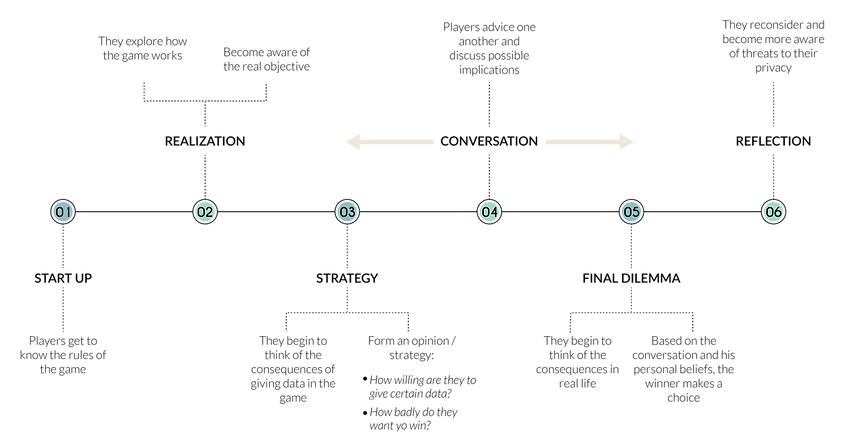
DataVrij
DataVrij is a digital board game about the privacy of personal data in online environments. It explores the concept of Personal Data as a Currency to make players aware of how often they get asked for their data, and how often they accept this kind of requests.
The game was carried out during an internship at MediaLab - Amsterdam University of Applied Sciences and it was designed for the Museum of the Dutch Institute for Sound and Vision. The main requirement from the Sound and Vision Museum was that the project prompted a conversation about privacy in online environments amongst families.
For this project, I worked with an international and interdisciplinary group of five people. My main roles were to plan user research, design paper prototypes, test them, and analyze the results to create new iterations. I also designed the final graphic appearance of the game.
Valentina Sierra
Aniek Breevoort
Manolis Fragkiadakis
Pradeep Siddappa
Dimitra Kousteridou
Client
The Netherlands Institute for Sound and Vision
Date
Feb. - Jun. 2016




The game has a path of tiles and the goal is to be the first player to reach its end. To achieve this, throughout the game players might land on “Data Tiles” where they have the choice of paying with (fill in) their personal information to get advantages like throw the dice again, move forward or send a competitor some positions back.
Each player has a phone during the game. They use it to roll the dice and fill in their data. All the information they type is visible on the board to the other players.
The first person to reach the end of the path faces one final decision: she can choose to win the game but all her personal data will be published in a high scoreboard that is visible for all the other visitors of the Museum, or the player can choose to keep her data safe but lose the game.
Game Stages
These are the phases the players go through during the game. The phases were defined based on the results of multiple prototypes and are necessary to facilitate the conversation about the privacy of personal data.




01. Start Up
02. Realization
03. Strategy
Players learn about the general rules of the game. In DataVrij, at this point, it is not completely evident that the game is about the threats to online privacy.
They encounter the hidden layer of the game when they have the option of paying with their data for the first time. When shocked by confronting questions, they start to think about what the game really entails.
As players realize the real intention of the game, they begin to create a strategy. They state their opinions and reconsider their choices based on how they feel with sharing their information.



04. Conversation
05. Final Dilemma
06. Reflection
When making the decision of whether or not to pay with data, players discuss and advice one another on which information they think is safe to share, which is not, and why.
The player who first reaches the end of the path sees all the information he gave and has the option of reconsidering if he is willing to make it public to win the game. Other players offer him their advice.
After playing the game, people will have a nagging feeling about it and the discussions it triggered. From now on, they will be more aware and think twice before giving their personal information.
Process
Research & Ideation
We conducted semi-structured interviews and observation of families visiting the Museum to get insights about who they were, what concerns about new media they had, and how they interacted with the museum installations. After analyzing that research, through tools like Customer Journey Maps and Personas, we came up with the concept of DataVrij.
When it was still an idea, the game consisted of a screen with two bicycles. On the screen, a city was displayed and players competed against each other to be the first to reach a certain place. To get advantages in the game (find shortcuts, increase speed and put obstacles to the opponent) players had to share their personal information. The concept behind this was Personal Data as a Currency. The form of the game changed throughout the prototyping process but the concept remained.





Prototypes
With every prototype, the game mechanics were adjusted to define the ones that brought the conversation to life and made the game fun and easy to understand.
The first prototype was a Monopoly board where instead of buying houses with money, players bought them with their data.
We identified two main aspects of the board game format that were critical for the development of DataVrij:
1. While one player is deciding whether or not to pay with her data, the other players cannot advance in the game. They are waiting for her to decide and that encourages them to make suggestions on what to do, to continue playing.
2. Being close to each other around the table creates a comfortable and safe environment to talk about topics like privacy. With similar game mechanics but in a larger format, the conversation was not triggered.
We created several versions of paper prototypes and once we defined the game mechanics that prompted the conversation, we moved from paper prototypes to a digital one.




© All Rights Reserved. 2023